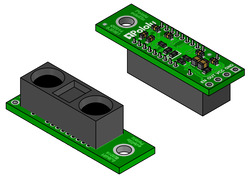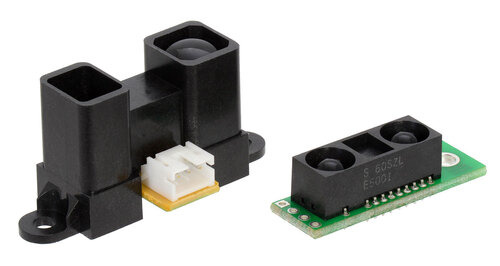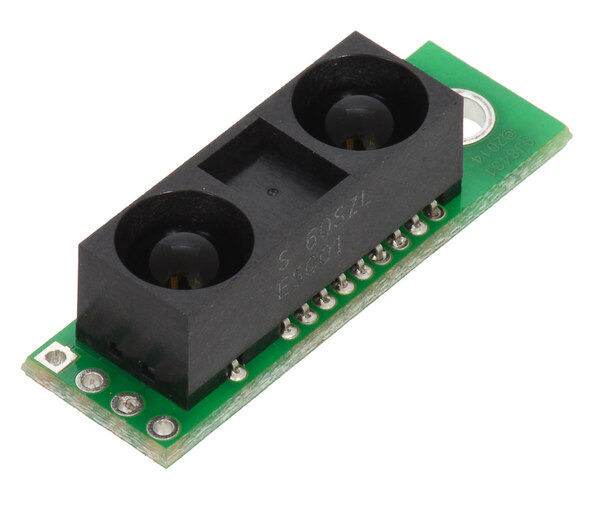Pololu Blog »
New products: Pololu Carriers with Sharp GP2Y0A60SZLF Analog Distance Sensor 10-150cm
 |
3D rendering of the Pololu carrier with Sharp GP2Y0A60SZLF distance sensor. |
|---|
We have released some simple boards over the past few weeks that were developed by our mechanical engineers (see earlier posts for Jon’s board and Brandon’s board). The board I got to design is a carrier board for the Sharp GP2Y0A60SZ 10-150cm analog distance sensor, which is a part we have been trying to get for almost five years.
While the board itself is simple, the GP2Y0A60SZ is exciting for us because it pretty much outperforms all of the other analog Sharp distance sensors. In particular, compared to the more expensive Sharp GP2Y0A02YK0F, which can also detect objects out to a maximum distance of 150 cm, the GP2Y0A60SZ offers half the minimum sensing distance (10 cm) and more than twice the update rate (60 Hz) in a much smaller package:
 |
Sharp GP2Y0A02YK0F Sensor 20-150cm (left) next to Pololu Carrier with Sharp GP2Y0A60SZLF Sensor 10-150cm (right). |
|---|
One application of these sensors that I am looking forward to is mini-sumo. The features on the sensor make them a great addition to a mini-sumo robot like the one I built for the LVBots mini-sumo competition last year. With these on my robot (the one with the Magikarp on it), I might be able to knock out a few more competitors the next time we have a competition.
5V and 3V versions available
Our sensor carrier is available in two versions: a 5V version for operation from 2.7 V to 5.5 V and a 3V version for operation from 2.7 V to 3.6 V:
 |
For more information, see the product pages or check out our entire category of optical range finders.
9 comments
Does this one fix the noise issues on the power line that the old one had (I had to add extra capacitors to clean up the power)?
Thanks!
I am glad you like the new sensor. Mounting holes are something the mechanical engineers always try to push for more of, but making the board compact is often a competing factor.
The carrier board for the sensor has capacitors to help with noise and should be significantly better than the older GP2Y0A02YK0F. However, the noise is also dependent on your setup so adding additional capacitors might help.
- Grant
could you tell me why, in datasheet GP2Y0A60SZ0F (3v) we have buy around 100 pcs of : Pololu Carriers with Sharp GP2Y0A60SZLF Analog Distance Sensor 10-150cm
but we looking for max mA needed by this module since in datasheet we have founded 2 differents values :
1) Average supply current : max 50mA
2) and in schematic: "Please use an electric source with an output current of 400mA or more because LED pulse current is more than 300mA."
I don't andestand ? what is in your carriers max mA ?
Best regards.
Like the datasheet says, those Sharp distance sensors draw current in bursts. So, when supplied power, the sensor will draw some nominal amount of current until the LED is pulsed and the current drawn increases to more than 300mA briefly. After the pulse, the current decreases again to the nominal amount. The average current draw of the sensor (which is the average of the nominal and pulse currents) is, like you noticed, described as typically 33mA, and at max a value of 50mA. The carrier board does not add hardware that changes this current draw noticeably.
-Jon
However, in this particular case (since your supply can output close to the current the sensor wants to draw) if you cannot use a source that can provide more current, you could probably still use the sensor with a large capacitor (>10 uF) between power and ground near the sensor board.
-Jon
thanks a lot for you time.
Do you know :
1) when the max pulse is operating (when the first powered and only or not ?)
2) and duration ?
Best regards
may be one max pulse after 1) first powered and for each wake up after pin EN activated ?
And third question: how activated/desactivated pin EN on arduino ? (need to add 10 kΩ pull-up resistor or it's already on your board ? ) in order to save power.
Best regards and thanks.
The schematic for that sensor's carrier board can be found on its product page. There is a 10k pull-up resistor on the EN pin. You can also see in the schematic that we label the Sharp sensor's VCTRL pin as EN, which should make it easier to understand the Timing Chart and see how the sensor responds to its EN pin being toggled.
By the way, if you have many detailed questions about one of the sensors we carry, we prefer to that you start a thread on our forum, which is a better venue to search through, and start a discussion on details like the ones you asked about.
-Jon









